gradient
A color gradient.
Typst supports linear gradients through the
gradient.linear function, radial gradients through
the gradient.radial function, and conic gradients
through the gradient.conic function.
A gradient can be used for the following purposes:
- As a fill to paint the interior of a shape:
rect(fill: gradient.linear(..)) - As a stroke to paint the outline of a shape:
rect(stroke: 1pt + gradient.linear(..)) - As the fill of text:
set text(fill: gradient.linear(..)) - As a color map you can sample from:
gradient.linear(..).sample(0.5)
Examples
#stack(
dir: ltr,
spacing: 1fr,
square(fill: gradient.linear(..color.map.rainbow)),
square(fill: gradient.radial(..color.map.rainbow)),
square(fill: gradient.conic(..color.map.rainbow)),
)
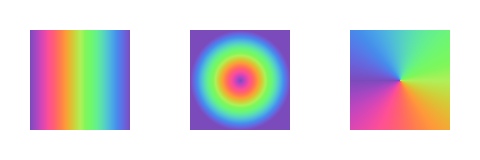
Gradients are also supported on text, but only when setting the
relativeness to either auto (the default value) or
"parent". To create word-by-word or glyph-by-glyph gradients, you can
wrap the words or characters of your text in boxes manually or
through a show rule.
#set text(fill: gradient.linear(red, blue))
#let rainbow(content) = {
set text(fill: gradient.linear(..color.map.rainbow))
box(content)
}
This is a gradient on text, but with a #rainbow[twist]!

Stops
A gradient is composed of a series of stops. Each of these stops has a color
and an offset. The offset is a ratio between 0% and 100% or
an angle between 0deg and 360deg. The offset is a relative position
that determines how far along the gradient the stop is located. The stop's
color is the color of the gradient at that position. You can choose to omit
the offsets when defining a gradient. In this case, Typst will space all
stops evenly.
Relativeness
The location of the 0% and 100% stops depends on the dimensions
of a container. This container can either be the shape that it is being
painted on, or the closest surrounding container. This is controlled by the
relative argument of a gradient constructor. By default, gradients are
relative to the shape they are being painted on, unless the gradient is
applied on text, in which case they are relative to the closest ancestor
container.
Typst determines the ancestor container as follows:
- For shapes that are placed at the root/top level of the document, the closest ancestor is the page itself.
- For other shapes, the ancestor is the innermost
blockorboxthat contains the shape. This includes the boxes and blocks that are implicitly created by show rules and elements. For example, arotatewill not affect the parent of a gradient, but agridwill.
Color spaces and interpolation
Gradients can be interpolated in any color space. By default, gradients are interpolated in the Oklab color space, which is a perceptually uniform color space. This means that the gradient will be perceived as having a smooth progression of colors. This is particularly useful for data visualization.
However, you can choose to interpolate the gradient in any supported color space you want, but beware that some color spaces are not suitable for perceptually interpolating between colors. Consult the table below when choosing an interpolation space.
| Color space | Perceptually uniform? |
|---|---|
| Oklab | Yes |
| Oklch | Yes |
| sRGB | No |
| linear-RGB | Yes |
| CMYK | No |
| Grayscale | Yes |
| HSL | No |
| HSV | No |
Direction
Some gradients are sensitive to direction. For example, a linear gradient has an angle that determines its direction. Typst uses a clockwise angle, with 0° being from left to right, 90° from top to bottom, 180° from right to left, and 270° from bottom to top.
#stack(
dir: ltr,
spacing: 1fr,
square(fill: gradient.linear(red, blue, angle: 0deg)),
square(fill: gradient.linear(red, blue, angle: 90deg)),
square(fill: gradient.linear(red, blue, angle: 180deg)),
square(fill: gradient.linear(red, blue, angle: 270deg)),
)
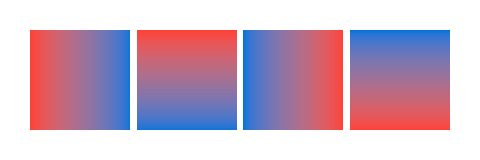
Presets
Typst predefines color maps that you can use with your gradients. See the
color documentation for more details.
定义
函数和类型可以有与其关联的定义 (成员或方法)。可以使用 "." 操作符来访问调用它们。
linear
Creates a new linear gradient, in which colors transition along a straight line.
 查看示例
查看示例
#rect(
width: 100%,
height: 20pt,
fill: gradient.linear(
..color.map.viridis,
),
)

stops
The color stops of the gradient.
space
The color space in which to interpolate the gradient.
Defaults to a perceptually uniform color space called Oklab.
默认:oklab
relative
The relative placement of the gradient.
For an element placed at the root/top level of the document, the parent is the page itself. For other elements, the parent is the innermost block, box, column, grid, or stack that contains the element.
-
"self"The gradient is relative to itself (its own bounding box).
-
"parent"The gradient is relative to its parent (the parent's bounding box).
默认:auto
dir
The direction of the gradient.
默认:ltr
angle
The angle of the gradient.
radial
Creates a new radial gradient, in which colors radiate away from an origin.
The gradient is defined by two circles: the focal circle and the end
circle. The focal circle is a circle with center focal-center and
radius focal-radius, that defines the points at which the gradient
starts and has the color of the first stop. The end circle is a circle
with center center and radius radius, that defines the points at
which the gradient ends and has the color of the last stop. The gradient
is then interpolated between these two circles.
Using these four values, also called the focal point for the starting circle and the center and radius for the end circle, we can define a gradient with more interesting properties than a basic radial gradient.
 查看示例
查看示例
#stack(
dir: ltr,
spacing: 1fr,
circle(fill: gradient.radial(
..color.map.viridis,
)),
circle(fill: gradient.radial(
..color.map.viridis,
focal-center: (10%, 40%),
focal-radius: 5%,
)),
)
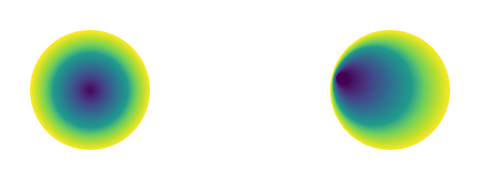
stops
The color stops of the gradient.
space
The color space in which to interpolate the gradient.
Defaults to a perceptually uniform color space called Oklab.
默认:oklab
relative
The relative placement of the gradient.
For an element placed at the root/top level of the document, the parent is the page itself. For other elements, the parent is the innermost block, box, column, grid, or stack that contains the element.
-
"self"The gradient is relative to itself (its own bounding box).
-
"parent"The gradient is relative to its parent (the parent's bounding box).
默认:auto
center
The center of the end circle of the gradient.
A value of (50%, 50%) means that the end circle is
centered inside of its container.
默认:(50%, 50%)
radius
The radius of the end circle of the gradient.
By default, it is set to 50%. The ending radius must be bigger
than the focal radius.
默认:50%
focal-center
The center of the focal circle of the gradient.
The focal center must be inside of the end circle.
A value of (50%, 50%) means that the focal circle is
centered inside of its container.
By default it is set to the same as the center of the last circle.
默认:auto
focal-radius
The radius of the focal circle of the gradient.
The focal center must be inside of the end circle.
By default, it is set to 0%. The focal radius must be smaller
than the ending radius`.
默认:0%
conic
Creates a new conic gradient, in which colors change radially around a center point.
You can control the center point of the gradient by using the center
argument. By default, the center point is the center of the shape.
 查看示例
查看示例
#stack(
dir: ltr,
spacing: 1fr,
circle(fill: gradient.conic(
..color.map.viridis,
)),
circle(fill: gradient.conic(
..color.map.viridis,
center: (20%, 30%),
)),
)
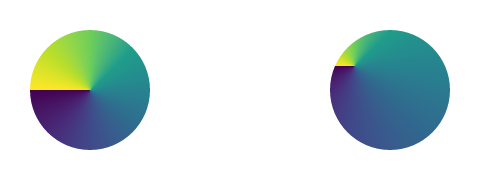
stops
The color stops of the gradient.
angle
The angle of the gradient.
默认:0deg
space
The color space in which to interpolate the gradient.
Defaults to a perceptually uniform color space called Oklab.
默认:oklab
relative
The relative placement of the gradient.
For an element placed at the root/top level of the document, the parent is the page itself. For other elements, the parent is the innermost block, box, column, grid, or stack that contains the element.
-
"self"The gradient is relative to itself (its own bounding box).
-
"parent"The gradient is relative to its parent (the parent's bounding box).
默认:auto
center
The center of the last circle of the gradient.
A value of (50%, 50%) means that the end circle is
centered inside of its container.
默认:(50%, 50%)
sharp
Creates a sharp version of this gradient.
Sharp gradients have discrete jumps between colors, instead of a smooth transition. They are particularly useful for creating color lists for a preset gradient.
 查看示例
查看示例
#set rect(width: 100%, height: 20pt)
#let grad = gradient.linear(..color.map.rainbow)
#rect(fill: grad)
#rect(fill: grad.sharp(5))
#rect(fill: grad.sharp(5, smoothness: 20%))
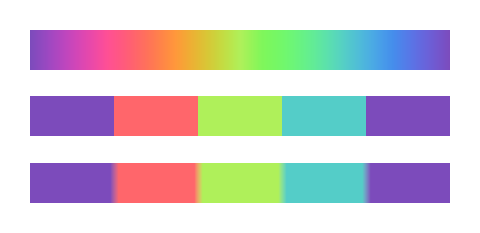
steps
The number of stops in the gradient.
smoothness
How much to smooth the gradient.
默认:0%
repeat
Repeats this gradient a given number of times, optionally mirroring it at each repetition.
 查看示例
查看示例
#circle(
radius: 40pt,
fill: gradient
.radial(aqua, white)
.repeat(4),
)

repetitions
The number of times to repeat the gradient.
mirror
Whether to mirror the gradient at each repetition.
默认:false
kind
Returns the kind of this gradient.
stops
Returns the stops of this gradient.
space
Returns the mixing space of this gradient.
relative
Returns the relative placement of this gradient.
angle
Returns the angle of this gradient.
sample
Sample the gradient at a given position.
The position is either a position along the gradient (a ratio
between 0% and 100%) or an angle. Any value outside
of this range will be clamped.
t
The position at which to sample the gradient.
samples
Samples the gradient at multiple positions at once and returns the results as an array.
ts
The positions at which to sample the gradient.